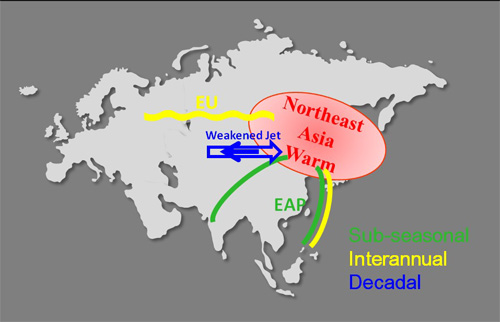Northeast Asia includes the areas of Northeast China, Russian Far East, Japan and Korean Peninsula. The summer climate over Northeast Asia is modulated not only by the East Asian monsoon system, but also by the disturbance from the mid-latitudes. And Northeast Asia is one of the sensitive regions to the global climate change. Thus, Northeast Asian summer climate variability occurs on different timescale. What are factors affecting the Northeast Asian climate variations? Are they the same on different timescale?

Schematic diagram for the Northeast Asian summer temperature and its associated circulation patterns on different timescale. (diagram credit: CHEN Wei)
Dr. CHEN Wei from the Institute of Atmospheric Physics (IAP/CAS) and her collaborators addressed these questions by investigating the variation of Northeast Asian summer temperature and its associated atmospheric circulation. On the sub-seasonal timescale, the Northeast Asia summer temperature is associated with the wave train from Indian Peninsula and modulated by the Indian monsoon rainfall during early-summer. However, during late-summer, it is related to the East Asia/Pacific wave pattern and affected by the convections over the Philippine sea.
On the interannual timescale, the Northeast Asian summer temperature exhibits not only a homogeneous temperature anomaly covering the whole area, but also a seesaw pattern, showing a contrasting distribution between East Asia and north of this region. Dr. CHEN observed, “Both modes contribute equivalently and greatly to the temperature anomalies over East Asia, although they exhibit different physical processes.” They found the first mode is related to the Eurasian teleconnection pattern, while the second one is associated with the East Asia/Pacific pattern.
On the decadal timescale, the Northeast Asian summer temperature experiences a decadal warming after mid-1990s. This warming is related to an anticyclonic circulation south of Lake Baikal and a weakened East Asian westerly jet, which could be a remote response of the increased precipitation over South China. "These results indicate a complication of Northeast Asian summer temperature." says Dr. CHEN, "attentions should be paid on different factors when the Northeast Asian climate anomaly occurs on different timescale."
The series of studies have been published in Advances in Atmospheric Sciences.
References
Chen, W., and R. Lu, 2014: The interannual variation in monthly temperature over Northeast China during summer. Adv. Atmos. Sci., 31, 515–524, doi: 10.1007/s00376-013-3102-3.
Chen, W., and R. Lu, 2014: A decadal shift of summer surface air temperature over the Northeast Asia around the mid-1990s. Adv. Atmos. Sci., 31, 735–742, doi: 10.1007/s00376-013-3154-4. (http://159.226.119.58/aas/EN/abstract/abstract2461.shtml)
Chen, W., X. W. Hong, R. Lu, A. F. Jin, S. Z. Jin, J.-C Nam, J.-H, Shin, T.-Y, Goo and B.-J. Kim, 2015: Variation in Summer Surface Air Temperature over Northeast Asia and Its Associated Circulation Anomalies. Adv. Atmos. Sci., doi: 10.1007/s00376-015-5056-0. (in press)
Contact: Dr. CHEN Wei, chenwei@mail.iap.ac.cn






